Originally posted by dragon
View Post
I use them about 140 Hz mostly and restrict the current through the primary by using one series capacitor 2.2 uF in the active line of each primary. I drive them with my converter which has two 240 volt out of phase outputs. restricting the primary current is essential with MOT's, with no current restriction the input power goes to over 500 watts at the flick of the switch. With 2.2 uf in one line of the primary the max input is about is about 80 watts per MOT at about 180 Hz. Each cycle the cap will only pass so much current, I can also use smaller ones for less current this would make it possible to connect to the wall or an appropriate inverter. But I do agree an oil filled "pig" would be nice to make, I have some transformer oil maybe I should boil some out and put a pair of MOTs in oil and crank them up to see what they can take.
To FRC, if the halide transformer has a 110 or 240 volt primary input you will need an appropriate AC source to drive them, I'm using a 12 to 240 volt home wound converter, the secondaries of my converter are very close to the 200 mH or so of the MOT's which is why it works well for me I think. I'm picking the fruits of a lot of difficult and time consuming work it took to build and wind the converter, I'm very happy with how it works though so far. I feel as though I could safely power my MOTs from the wall but that's only because of the experiments I've done with the converter slowly bringing the frequency down and power up till I have what I want and can use them at 60 Hz with reasonably low input power. But I still wont do it, I've been electrocuted by 240 from the grid and I know what it feels like, I don't think my body could take it now at my age. I handle the 240 volt outputs at over 20 Khz but when I use 60 hz I don't touch anything while it's turned on. My feeling is that a small commercial 150 watt inverter or something might no take driving a transformer very well but I really don't know, that could be an option.
What are the input and output voltages of the halide transformer ?
I'll make a drawing of how I use the series capacitor to restrict the primary current.
What I find is that driving a coil like a flyback or ignition coil with DC pulses using a transistor the transistor heats up from the transients in the primary but using AC that's not a problem. A two phase inverter circuit has the advantage of switching the primary current back and forth which means when there is no load the flux will build to maximum and the transformer will idle with very little current draw and virtually no heating of the transistors and very few transients. So I use AC to drive the HV transformers then rectify the HV to use HV DC for the primary tank circuit. This way the transistors switching the supply current from the source battery don't overheat even when switching 100 watts. Try switching 100 watts DC one way through a transformer or coil with out removing or suppressing the spikes or active cooling and the transistor probably wont last very long. With less than 1 amp at 12 volts (10 watts) it might be OK but 100 watts might tell a different story.

Remember when there is a chance of a shock keep your left hand in your pocket.
Cheers
 As you point out that wave form is not “clean “ and you are telling me I will not find a resonant point with such an input. I've never built a Tesla coil before apart from as part of a science group at school about a million years ago and so I dont really know if that horrible waveform does in theory have a resonant point somewhere,
As you point out that wave form is not “clean “ and you are telling me I will not find a resonant point with such an input. I've never built a Tesla coil before apart from as part of a science group at school about a million years ago and so I dont really know if that horrible waveform does in theory have a resonant point somewhere, I know Iv'e wound a coil to its nominal frequency (and It is very Nominal) and I think if there is (in theory) any resonant point I havent found it!quite apart from that this particular NST has an Earth leakage system which keeps operatring !
I know Iv'e wound a coil to its nominal frequency (and It is very Nominal) and I think if there is (in theory) any resonant point I havent found it!quite apart from that this particular NST has an Earth leakage system which keeps operatring !









Comment